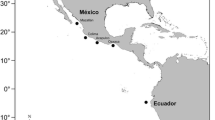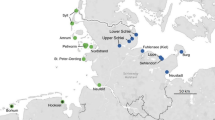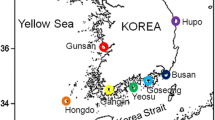Abstract
The genetic structure of seven sailfish Istiophorus platypterus populations sampled from three locations inside and four locations outside the Arabian Gulf was determined by restriction fragment length polymorphism analysis of mitochondrial DNA of 147 individuals using eight restriction endonucleases. A total of 39 composite haplotypes derived from 27 presumptive restriction sites demonstrated significant differences in frequency between population groups inside and outside the Gulf (analysis of molecular variance 34.80%, P<0.001; F ST=0.356) and evidence of restricted migration between them (average number of migrants, N m=0.903). Haplotypes found only inside or outside the Gulf clustered to all major branches of a haplotype phylogeny, as did those found in both areas. The reduced genetic diversity of the Gulf populations and the fact that much of the differentiation between the population groups resulted from differences in haplotype frequency rather than divergence between haplotypes suggest a founder effect and a recent sampling of genotypes from the Indian Ocean. This was probably associated with dispersal into the Gulf after it was flooded by rising sea level after the end of the last glaciation around 8,000 years ago. At some point since then the population has evolved to complete its life cycle within the Gulf and shows a marked disruption to gene flow, consistent with dispersal data, at the Strait of Hormuz. These findings represent the first clear evidence of phylogeographic isolation occurring in a large, highly vagile, predatory istiophorid billfish, within a marginal sea.





Similar content being viewed by others
References
Avise JC (1994) Molecular markers, natural history and evolution. Chapman & Hall, New York
Bermingham E, Moritz C (1998) Comparative phylogeograpy: concepts and applications. Mol Ecol 7:367–369
Brewer PG, Dyrssen D (1985) Chemical oceanography of the Persian Gulf. Prog Oceanogr 14:41–55
Buonaccorsi VP, Reece KS, Morgan LW, Graves JE (1999) Geographic distribution of molecular variance within the blue marlin (Makaira nigricans): a hierarchical analysis of allozyme, single-copy nuclear DNA, and mitochondrial DNA markers. Evolution 53:568–579
Burton RS (1998) Intraspecific phylogeography across the Point Conception biogeographic boundary. Evolution 52:734–745
Chakraborty R (1990) Mitochondrial DNA polymorphism reveals hidden heterogeneity within some Asian populations. Am J Hum Gen 47:87–94
Chow S, Takeyama H (2000) Nuclear and mitochondrial DNA analyses reveal four genetically separated breeding units of the swordfish. J Fish Biol 56:1087–1098
Chow S, Okamoto H, Uozumi Y, Takeuchi Y, Takeyama H (1997) Genetic stock structure of the swordfish (Xiphias gladius) inferred by PCR_RFLP analysis of the mitochondrial DNA control region. Mar Biol 127:359–367
Di Rienzo A, Wilson AC (1991) Branching pattern in the evolutionary tree for human mitochondrial DNA. Proc Natl Acad Sci U S A 88:1597–1601
Excoffier L, Smouse P, Quattro J (1992) Analysis of molecular variance inferred from metric distances among DNA haplotypes: application to human mitochondrial DNA restriction data. Genetics 131:479–491
Féral JP (2002) How useful are the genetic markers in attempts to understand and manage marine biodiversity? J Exp Mar Biol Ecol 268:121–145
Finnerty JR, Block BA (1992) Direct sequencing of mitochondrial DNA detects highly divergent haplotypes in blue marlin (Makaira nigricans). Mol Mar Biol Biotechnol 1:206–214
Finnerty JR, Block BA (1995) Evolution of cytochrome b in the Scombroidei (Teleostei): molecular insights into billfish (Istiophoridae and Xiphiidae) relationships. Fish Bull 93:78–96
Goudet J, Raymond M, de Meeüs T, Rousset F (1996) Testing differentiation in diploid populations. Genetics 144:1933–1940
Graves JE (1998) Molecular insights into the population structures of cosmopolitan marine fishes. J Hered 89:427–437
Graves JE, McDowell JR (1994) Genetic analysis of striped marlin (Tetrapturus audax) population structure in the Pacific Ocean. Can J Fish Aquat Sci 51:1762–1768
Graves JE, McDowell JR (1995) Inter-ocean genetic divergence of istiophorid billfishes. Mar Biol 122:193–203
Graves JE, McDowell JR (1998) Population genetic structure of Atlantic istiophorid billfishes [SCRS/96/107]. Report of the third ICCAT billfish workshop. Collect Vol Sci Pap ICCAT 47:329–342
Graves JE, McDowell JR (2003) Stock structure of the world’s istiophorid billfishes: a genetic perspective. Mar Freshw Res 54:287–298
Hoolihan J (2001) Sailfish tagging in the Arabian Gulf. In: Goddard S, Al-Oufi HS, McIlwain J, Clareboudt M (eds) First international conference on fisheries, aquaculture and environment in the northwest Indian Ocean. Sultan Qaboos University, Oman, pp 86–90
Hoolihan J (2003) Sailfish movement in the Arabian Gulf: a summary of tagging efforts. Mar Freshw Res 54:509–513
Hoolihan J (2004) Managing Arabian Gulf sailfish—issues of transboundary migration. In: Payne A, O’Brien C, Rogers S (eds) Management of shared fish stocks. Blackwell, Oxford, in press
Innes BH, Grewe PM, Ward RD (1998) PCR-based genetic identification of marlin and other billfish. Mar Freshw Res 49:383–388
Mantel N (1967) The detection of disease clustering and a generalized regression approach. Cancer Res 27:209–220
McDowell J, Graves JE (2001) A genetic perspective on Atlantic sailfish stock structure. Collect Vol Sci Pap ICCAT 54:805–810
McDowell JR, Graves JE (2002) Nuclear and mitochondrial DNA markers for specific identification of istiophorid and xiphiid billfishes. Fish Bull 100:537–544
McElroy D, Moran P, Bermingham E, Kornfield I (1992) REAP: an integrated environment for the manipulation and phylogenetic analysis of restriction data. J Hered 83:157–158
Miller MP (1997) TFPGA (Tools for Population Genetic Analyses) version 1.3. Distributed by the author. Department of Biological Sciences, Northern Arizona University, Flagstaff, Ariz.
Moritz C, Faith DP (1998) Comparative phylogeography and the identification of genetically divergent areas for conservation. Mol Ecol 7:419–429
Myers RA, Worm B (2003) Rapid worldwide depletion of predatory fish communities. Nature 423:280–283
Nakamura I (1985) FAO species catalogue, vol 5. Billfishes of the world. An annotated and illustrated catalogue of marlins, sailfishes, spearfishes and swordfishes known to date. FAO fisheries synopsis. FAO/UNDP, Rome
Nei M, Tajima F (1981) DNA polymorphism detectable by restriction endonucleases. Genetics 97:145–163
Page RDM (1996) TREEVIEW: an application to display phylogenetic trees on personal computers. Comput Appl Biosci 12:357–358
Palumbi S, Martin A, Romano S, McMillan WO, Stice L, et al. (1991) The simple fool’s guide to PCR. Department of Zoology and Kewalo Marine Laboratory, University of Hawaii, Honolulu
Palumbi SR (1994) Genetic divergence, reproductive isolation, and marine speciation. Annu Rev Ecol Syst 25:547–572
Raymond M, Rousset F (1995) An exact test for population differentiation. Evolution 49:1280–1283
Reynolds RM (1993) Physical oceanography of the Gulf, Strait of Hormuz, and the Gulf of Oman—results from the Mt Mitchel Expedition. Mar Pollut Bull 27:35–59
Rogers AR, Harpending H (1992) Population growth makes waves in the distribution of pairwise genetic differences. Mol Biol Evol 9:552–569
Schneider S, Roessli D, Excoffier L (2000) Arlequin ver. 2.000: a software for population genetics data analysis. Genetics and Biometry Laboratory, University of Geneva, Switzerland
Seutin G, White BN, Boag PT (1991) Preservation of avian blood and tissue samples for DNA analysis. Can J Zool 69:82–90
Sheppard C, Price A, Roberts C (1992) Marine ecology of the Arabian region—patterns and processes in extreme tropical environments. Academic Press, London
Stepien CA, Rosenblatt RH, Bargmeyer BA (2001) Phylogeography of the spotted sand bass, Paralabrax maculatofasciatus: divergence of Gulf of California and Pacific coast populations. Evolution 55:1852–1862
Sultan SAR, Elghribi NM (1996) Temperature inversion in the Arabian Gulf and the Gulf of Oman. Cont Shelf Res 16:1521–1544
Tajima F (1989a) Statistical method for testing the neutral mutation hypothesis by DNA polymorphism. Genetics 123:585–595
Tajima F (1989b) The effect of change in population size on DNA polymorphism. Genetics 123:597–601
Teller JT, Glennie KW, Lancaster N, Singhvi AK (2000) Calcareous dunes of the United Arab Emirates and Noah’s flood; the postglacial reflooding of the Persian (Arabian) Gulf. Quaternary Intl 68–71:297–308
Terry A, Bucciarelli G, Bernardi G (2000) Restricted gene flow and incipient speciation in disjunct Pacific Ocean and Sea of Cortez populations of a reef fish species, Girella nigricans. Evolution 54:652–659
Ward RD (2002) Genetics of fish populations. In: Hart PJB, Reynolds JD (eds) Handbook of fish biology and fisheries. Blackwell, Oxford, pp 200–224
Acknowledgements
We wish to thank the following for contributing to tissue sample collection: Ali Abdul Aziz Al-Arami (Oman), Angus Paul (Kenya), Iranian Fisheries Research Organization (Iran), Seychelles Fishing Authority (Seychelles), Andy De Maré (Dubai), Xavier Eichaker and Greg Heinricks (Abu Dhabi). In addition, gratitude is extended to the staff of the Centre for Marine and Coastal Studies (University of New South Wales, Sydney, Australia) for assistance in data analysis; and to the Environmental Research and Wildlife Development Agency (ERWDA) for project funding and ERWDA’s management for their support.
Author information
Authors and Affiliations
Corresponding author
Additional information
Communicated by O. Kinne, Oldendorf/Luhe
Rights and permissions
About this article
Cite this article
Hoolihan, J.P., Premanandh, J., D’Aloia-Palmieri, MA. et al. Intraspecific phylogeographic isolation of Arabian Gulf sailfish Istiophorus platypterus inferred from mitochondrial DNA. Marine Biology 145, 465–475 (2004). https://doi.org/10.1007/s00227-004-1346-2
Received:
Accepted:
Published:
Issue Date:
DOI: https://doi.org/10.1007/s00227-004-1346-2




